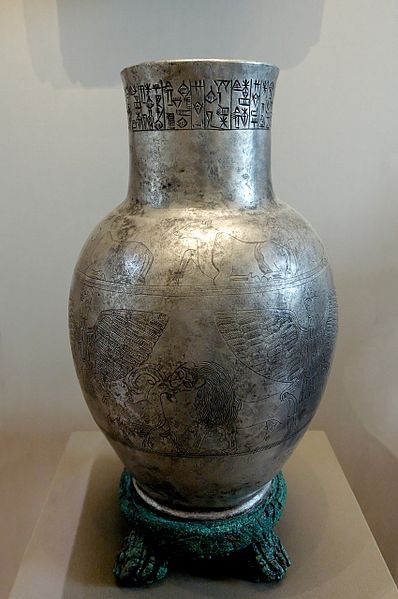ESA Mars Valles Marineris
- thought for the day extra
The above is the silver vase of Entemena. He was a Sumerian king of 2400 B.C. The metallergy may not be significantly earlier than other examples of metallergy, but this one has artwork showing symmetry patterns. This example of symmetry also may not be the first and earliest known; but, off the top of my head, this is pretty early to see such precise logical patterning. For instance, in cave paintings, however beautiful and not to bad, they are arbitrary. There's even very creative combinations of animals; but, there's no real use of symmetries. I've noted to others that what seems to me to separate the Egyptian pyramics from say the ruins of Malta(which are tremendous especially when you see the underground stuff!), or even the Stonehenge, the difference is mathematical precision. I go further in this artistic progress of Homo Sapiens.
Symmetry can be viewed as a kind of mathematics just like the way the ancients may have ordered counting by counting both fingers and toes in various patterns. This proto-mathematics of symmetry also corresponds to what I've been pointing out about Jacob Bronowski's ideas about the nature and origin of mathematics(and the correspondence to some historical findings of James Burke in his Connections and "the Day the Universe Changed"). If you keep in mind symmetry, then just by looking at one side of a pattern, one could derive what the opposite side looks like, or that a certain pattern keeps going. I mean to point out how daming up nature leads to infered units; as for instance in agriculturalism, by clearing the fields, one gets the concepts, perhaps vaguely at first, irrigation, pest control, and fertilization. In symmetry, one can note the pattern on one side(daming up nature), and derive(infered units) what the pattern looks like on the other side.
Another issue from the history of symmetry in the evolution of Homo Sapien intelligence is that of people playing with concepts long before they ever have a mathematical understanding; or their mathematical understanding is not the mathematical understanding found much later. Mathematicians note that sometimes historians have been too hasty to read into Appollonius's Conics work an anticipation of Rene Descartes analytic geometry and the use of coordinate geometry. Similarly, some people have tried to say that the Greeks knew group theory because eighteen hundreds mathematicians redefined the study of geometry as the study of group theory(Felix Klien's Erlanger program).
Similarly, mathematicians will tell you that group theory is the mathematics of symmetry, and this theory wasn't concieved till the eighteen hundreds. Group theory actually comes out of Galois theory. Galois theory is more than group theory. Let me just say that the Galois theory solution to the fifth degree equation(kind of like the fifth degree version of the well known quadratic formula) is kind of like a group theory version of finding the prime factorisation of a number. With suitable definitions of groups, simple groups, maximal groups, one tries to find a chain of subgroups that are prime; if the group chain is prime, the fifth degree equation is solvable(generally, the fifth degree is not solvable). Galois theory has been generalised many times and gets into many other problems such as finding all the given functions that solve a particular problem. But, the point I want to make is that groups are actually kind of 'infered units" of the galois theory.
Getting back to the anticipations of an arbitrary mathematical concept, mathematicians have noted that Greek geometry is group theoretic; but, of course, they didn't know any group theory. They did have interests in symmetry, especially ratios and proportions. But, for the most part, the Greeks kind of played with some group theory without knowing anything about groups. I bring this up because I'd suggest that likewise, people and mathematicians may have created mathematics and done logic subconsciously long before Aristotle made the first systematic account of deductive logic. I'm argueing all this to further argue my case for Jacob Bronowski's ideas in his "Origin of Knowledge and Imagination." After all, mathematicians have been creating mathematics for thousands of years without knowking anything about how the brain actually works.
------------------------------
Fluorescence Enhancement at Docking Sites of DNA-Directed Self-Assembled Nanoantennas
Active, motor-driven mechanics in a DNA gel
Muscle-like Supramolecular Polymers: Integrated Motion from Thousands of Molecular Machines
I point out the above three dna-nanotech articles because they're not breakthroughs in dna-nanomanufacturing techniques as much as they are the use of a dna-nanomanufacturing ability mature enough that arbitrary researchers are using it to make stunning and novel technological breakthroughs. There's likewise been many articles about making dna-nanomachines to cure cancer and do other medical accomplishments. We live in a nanomanufacturing era! The article below is an article about advancements in dna and rna nanomanufacturing. Dna-nanomanufacturing can organise, but it can't directly do chemical reactions. It could perhaps sooner than later organise moleculars like enzymes that can perform chemical reactions; another way to do chemical reactions is rna-nanotechnology; this is a remarkable article on what it took to learn about rna chemistry ability. Theorists have for a long time derived the existence of riboswitches, but this achieves experimental breakthroughs!
Direct Observation of Cotranscriptional Folding in an Adenine Riboswitch



No comments:
Post a Comment